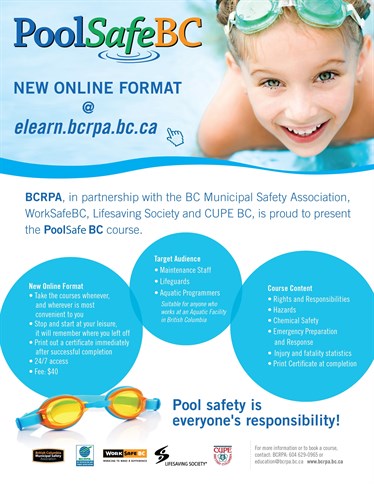The goal of this training is to provide aquatic centre staff with the knowledge and skills needed to recognize, evaluate, and control hazards in a pool setting in BC.
PoolSafeBC course content includes:
- Rights and responsibilities of employers and workers
- Hazards
- Chemical safety
- Emergency preparation and response
View the Course Outline in a PDF, or learn more below.
Delivery Format
Available on the BCRPA's eLearning website, and is approximately 3 to 4 hours in duration. Course material binder is NOT available for this format. A 70% passing grade on the exam is required in order to receive a Certificate of Completion

In-person workshops are 8 hours in duration. Participants will receive a course material binder. A passing grade of minimum 70% on the comprehension test is required in order to receive a certificate of participation. Course content consists of:
Review the course outline below.
Goal: Identify and describe legal responsibilities in pool operations
Learning objectives:
- Identify the primary accident types and causes of injury in pool facilities
- Identify rights and responsibilities of employers, supervisors and workers
- Identify components of Health and Safety Program
Goal: Recognize, evaluate and identify how to control the hazard in aquatic facilities
Learning objectives:
- Define occupational exposure
- Identify causes of poor air quality
- Identify components of an indoor air quality improvement program
- Identify heat stress disorders, symptoms, treatments and controls
- Review the education and training requirements related to heat stress
- Identify biohazards in an aquatic centre
- Review the requirements for vaccination
Goal: Recognize, evaluate and identify how to control the hazard in aquatic facilities
Learning objectives:
- Explain lock-out requirements and safe work procedures in aquatic centres
- Explain the components of a confined space entry program
- Identify confied spaces in aquatic facilities
Goal: Recognize, evaluate and identify how to control the hazard in aquatic facilities
Learning objectives:
- Explain fatigue issues and identify the associated safety risks
- Identify noise hazards in pool settings
- Describe protective measures against noise hazards
- Identify fall hazards in a pool setting
- Explain fall protection requirements including the hierarchy of controls
- Describe muscoskeletal injuries
- Describe methods to prevent back strain
Goal: Recognize, evaluate and identify how to control hazards associated with chemicals used in aquatic facilities
Learning objectives:
- Describe chemical hazards in aquatic facilities
- Recognize, evaluate and control hazards associated with toxic process gases
- Describe authorized entry and alarm system requirements to a chlorine room
- Recognize, evaluate and identify how to control hazards associated with salt chlorination, electrolytic chlorine generators, hypochlorites, and bromine
- Identify treatment chemicals and associated hazards in pool facilities
- Identify the testing chemicals and associated hazards in pool facilities
- Review WHMIS program components related to pool chemicals
- Explain the personal protective equipment required for working with chemicals
- Identify respiratory protection requirements
- Explain respirator fit test and fit check procedures
Goal: Describe the regulations and procedures associated with emergency preparedness and response in aquatic settings
Learning objectives:
- Explain and discuss requirements for first aid in an aquatic facility
- Identify risks associated with working alone or in isolation
- Create a risk assessments for working alone or in isolation
- Identify risks associated with violence in the workplace
- Create a risk assessment for violence in the workplace
- Explain emergency procedures for an aquatic centre
- Determine the key elements of an emergency program and develop an emergency plan
30 minute comprehenstion test. Passing mark is 70%.
For more information, please contact the Education & Initiatives department at education@bcrpa.bc.ca